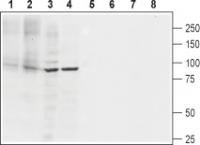Atp2a2 Rabbit Polyclonal Antibody
Other products for "Atp2a2"
Specifications
| Product Data | |
| Applications | IF, WB |
| Recommended Dilution | WB: 1:200-1:2000; FC: 1:50-1:600 |
| Reactivities | Human, Mouse, Rat |
| Host | Rabbit |
| Clonality | Polyclonal |
| Immunogen | Peptide CTPNKPSRTSMSK, corresponding to amino acid residues 498- 510 of rat SERCA2. 2nd cytoplasmic loop. |
| Formulation | Lyophilized. Concentration before lyophilization ~0.8mg/ml (lot dependent, please refer to CoA along with shipment for actual concentration). Buffer before lyophilization: phosphate buffered saline (PBS), pH 7.4, 1% BSA, 0.05% NaN3. |
| Purification | Affinity purified on immobilized antigen. |
| Conjugation | Unconjugated |
| Storage | Store at -20°C as received. |
| Stability | Stable for 12 months from date of receipt. |
| Gene Name | ATPase sarcoplasmic/endoplasmic reticulum Ca2+ transporting 2 |
| Database Link | |
| Background | Three Ca2+ ATPases have been described in mammalian cells. They are located in the plasma membrane, endoplasmic reticulum or the Golgi apparatus. SERCA pumps are located in both the endoplasmic reticulum and in the Golgi membranes. They are known to transport two Ca2+ molecules per hydrolysis of one ATP. Their structure includes ten transmembrane domains and their main role is to remove cytoplasmic Ca2+ ions in order to promote muscle relaxation. In mammals three genes encode three SERCA pumps. Each transcript undergoes tissue-dependent alternative splicing. SERCA1a and 1b are expressed in adult and neonatal skeletal muscle respectively. SERCA2a is also expressed in skeletal muscle, while SERCA2b is ubiquitously expressed. SERCA3 is expressed in a limited number of non-muscle cells. Although all SERCAs are regulated, SERCA2b undergoes extensive regulation at the protein level, such as protein-protein interaction, phosphorylation and glycosylation. SERCA2 catalyzes the hydrolysis of ATP coupled with the translocation of calcium from the cytosol into the sarcoplasmic reticulum lumen, and is involved in regulation of the contraction/relaxation cycle. Mutations in this gene cause Darier-White disease, also known as keratosis follicularis, an autosomal dominant skin disorder characterized by loss of adhesion between epidermal cells and abnormal keratinization. |
| Synonyms | ATP2B; DAR; DD; DKFZp686P0211; FLJ20293; FLJ38063; MGC45367; SERCA2 |
| Reference Data | |
Documents
| Product Manuals |
| FAQs |
{0} Product Review(s)
0 Product Review(s)
Submit review
Be the first one to submit a review
Product Citations
*Delivery time may vary from web posted schedule. Occasional delays may occur due to unforeseen
complexities in the preparation of your product. International customers may expect an additional 1-2 weeks
in shipping.






























































































































































































































































 Germany
Germany
 Japan
Japan
 United Kingdom
United Kingdom
 China
China




